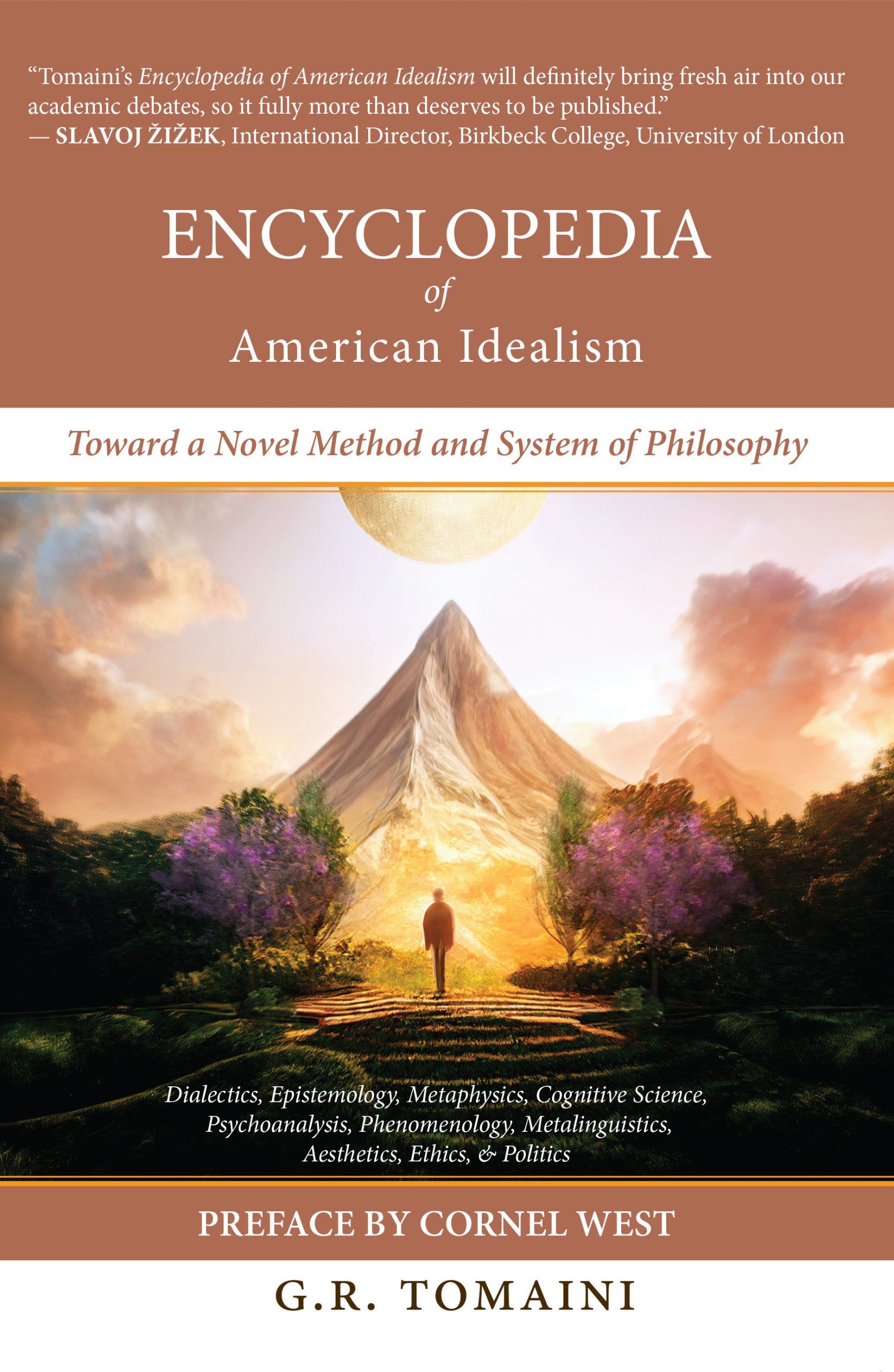
An Excerpt from Encyclopedia of American Idealism: Toward a Novel Method and System of Philosophy by G.R. Tomaini (Manticore Press)
 How human beings perform, how they produce, etc., all of this is dependent upon the Hegelian-Lacanian Linguistic Superstructure of the time — which is to say, it is all dependent upon the zeitgeist active at the moment of production of the speech, act, or thought. Thus, human beings attempt, as best as possible, to conform their behaviors to what is fashionable at the times. While fashion does not replace aesthetics or ethics, which are perpetual scientific endeavors that humankind engages in, fashion is responsible for what theologian John Calvin would call adornments, or what legal philosopher Kenji Yoshino would call coverings of the Core Script. Following famous philosopher of gender, Judith Butler, and philosophers J.L. Austin and Jürgen Habermas, human beings engage in performances via their productions of Mind. Every modality of production involves two distinct kinds of components: ethically necessary components, and ethically unnecessary components. While zeitgeistal fashion may affect the ethically necessary components of an action, which, in theory, should be universal to all peoples across all times, it is mostly the case that fashion affects ethically unnecessary components of products of Mind. This is to say, that there are both spurious and serious components of the products of Mind: fashion is the science of the spurious components of products of Mind: it matters not whether or not such and such a spurious and ethically unnecessary component of the product of Mind is altered, whereas, with the serious and ethically necessary components of a product of Mind, any alteration of the product of Mind makes all the difference in the world, because such an alteration could be the difference between a benefic product of Mind and a malefic product of Mind.
How human beings perform, how they produce, etc., all of this is dependent upon the Hegelian-Lacanian Linguistic Superstructure of the time — which is to say, it is all dependent upon the zeitgeist active at the moment of production of the speech, act, or thought. Thus, human beings attempt, as best as possible, to conform their behaviors to what is fashionable at the times. While fashion does not replace aesthetics or ethics, which are perpetual scientific endeavors that humankind engages in, fashion is responsible for what theologian John Calvin would call adornments, or what legal philosopher Kenji Yoshino would call coverings of the Core Script. Following famous philosopher of gender, Judith Butler, and philosophers J.L. Austin and Jürgen Habermas, human beings engage in performances via their productions of Mind. Every modality of production involves two distinct kinds of components: ethically necessary components, and ethically unnecessary components. While zeitgeistal fashion may affect the ethically necessary components of an action, which, in theory, should be universal to all peoples across all times, it is mostly the case that fashion affects ethically unnecessary components of products of Mind. This is to say, that there are both spurious and serious components of the products of Mind: fashion is the science of the spurious components of products of Mind: it matters not whether or not such and such a spurious and ethically unnecessary component of the product of Mind is altered, whereas, with the serious and ethically necessary components of a product of Mind, any alteration of the product of Mind makes all the difference in the world, because such an alteration could be the difference between a benefic product of Mind and a malefic product of Mind.
Thus, fashion is the science of the arbitrary, but, the collective subliminal prioritization selects this arbitrary cultural specification, and thus, it is not arbitrary per se — in fact it is quite necessary given the collective subliminal prioritization of the society that brings the given fashionable trend into existence. What, then, are the fashions that transcend their very own zeitgeists and that allow their bearers to conform to any conceivable fashion of the times? Let us examine three historical figures and their phenomenologies, and consider how an analysis of their ontologies might contribute to a Universal Theory of Fashionable Consciousness, or, a phenomenological consciousness that is best able to attune itself to the fashions of whatever zeitgeist it lives under. These three historical figures are none other than: John Keats, the Marquis de Sade, and George Gordon, Lord Byron. Let us now interrogate their phenomenologies. Keats was an inhibited, dependent, impotent, and juvenile consciousness — truly, Keats was a cuck’s cuck. Inhibited, because he let his morality strangle him into a life of quiet, gentle loves; dependent, because his love for Fanny colonized his Mind; impotent, because he had to sublimate his will to power into poetry; and juvenile, because he did not live too long of a life, and best therefore reflected the immature consciousness. Sade, on the other hand, lived a life of malefically uninhibited, dependent, potent, and devious consciousness. Maleficially uninhibited, because his sexual and emotional appetites were extremist in nature; dependent, because his Mind was colonized by his warped appetites; potent, because he was a wealthy Marquis, and hence could mostly get whatever he wanted, however egregious it was; devious, because his products of Mind were incontestably quite malefic: if you have not read Sade’s 120 Days of Sodom, save yourself the trouble, but, if you were into that sort of thing, best you ignored that work — for it is child’s play compared to Charles Dickens’s Great Expectations, wherein Miss Havisham emotionally vanquishes people merely for the sheer satisfaction of it all — thus, we may replace Sadism with Havishamism; famous philosopher Simone de Beauvoir wrote about Sade, but did not see the writing on the wall: that Sade was merely a materialist, and not a spiritualist: as the Christian martyrs of old teach us, the body is not long of this world, etc.
Therefore, Havishamism is more formidable than Sadism due to the fact that it strikes not at the body but at the Core Script — the very essence of an individual. This is not to say that either Sadism or Havishamism can compete with Antonin Artaud’s Theater of Cruelty, wherein audience members of his plays are subjected to attacks on their most primitive forms of ideology. Returning to Keats and Sade: might there be a Leibnizian aufhebung between these two extremes of consciousness? Arguably, it exists within the phenomenology of George Gordon, Lord Byron, the famous poet, adventurer, and cosmopolitan citizen of the world. Byron affected a beneficially uninhibited, independent, effective, and cosmopolitan consciousness. Uninhibited, because he was always very open-Minded across the span of his life; independent, because he was so open to traveling all over Europe, leaving friends and family behind; effective, because he balanced his fame and celebrity and became a war hero; cosmopolitan, because he viewed every struggle as part of the universal, perpetual endeavor for political justice, as he risked his life to fight in the Greek War of Independence, and ended up dying of a fever. Thus, we can derive, that Keatsian and Sadistic phenomenologies, are insufficient for affecting a transcendence of the zeitgeist, which is to say, their phenomenologies never quite reached the apex that Byron’s did, and hence, they never transcended their own zeitgeists in the ways that Byron did. Thus, Byron becomes an example of the universally fashionable consciousness: Byron’s phenomenology comes closest to resembling the ever-pursued, perpetual endeavor that is the Benefic consciousness. Because Byron’s consciousness was beneficially uninhibited, independent, effective, and cosmopolitan, it most resembles the mature consciousness that was discussed earlier on in this work. The mature consciousness is what human beings must become descriptively, but the benefic consciousness is what we ought to be prescriptively; but it is the democratic consciousness that is the most perfect and zeitgeistally transcendent mode of phenomenology, whether or not we can attain it is quite noumenal: it is similar to the Buddhist conception of enlightenment, where very few actually attain enlightenment, because it is such a high-caliber accomplishment, and even if an individual has attained enlightenment, it is hard for most individuals to discern that this elevation of consciousness has occurred. Because ethics itself is a perpetual scientific endeavor, it is fundamentally a noumenal field, and the owl of Minerva — again — only takes its flight at the break of dusk, thus, we cannot know what is right, but nevertheless, in the spirit of Immanuel Kant, we must seek to know what is right.
Thus, Byron exists as a sort of modal role model, as his modality of consciousness transcended his own zeitgeist, and made him a unique, fashionable figure. And yet, while Bryon’s modality of consciousness indeed transcends its zeitgeist, the essence of the Byronic consciousness is itself the fashionable consciousness, or that consciousness which is capable of not only surviving but also thriving under any possible zeitgeist: the fashionable consciousness is fundamentally adaptive to the zeitgeistal fashions of its time, and adapts to the ethically unnecessary aspects of social production, which are ethically unimportant, but are culturally of the highest importance. Indeed, an individual who is not up with the fashions of the times may be read as highly eccentric, perhaps not even worth engaging with. Here arises the litmus test for the fashionable consciousness: should the individual be transported into another zeitgeistal time period, would they either thrive or decline? The fashionable consciousness is that consciousness who would thrive and therefore adapt to the culture of the zeitgeistal times. Importantly, this consciousness is not the benefic consciousness, because it is not necessarily moral in that it accords its social productions to what is ethically necessary — that is not required of this modality of consciousness. Instead, this consciousness is focused only with keeping up with the times — which itself is important because of the autodiversification of the Core Script, which is autometanoia, but more generally speaking, keeping up with the times is important because the zeitgeist autodiversifies itself on a constant and regular basis. Thus, zeitgeistology is the discipline most on the mind of the fashionable consciousness, and Lord Byron’s modality of consciousness best represented the ideal of the fashionable consciousness. So much then for the fashionable consciousness as that consciousness that thrives and adapts to all cultural changes, and hence is a natural cosmopolitan.

